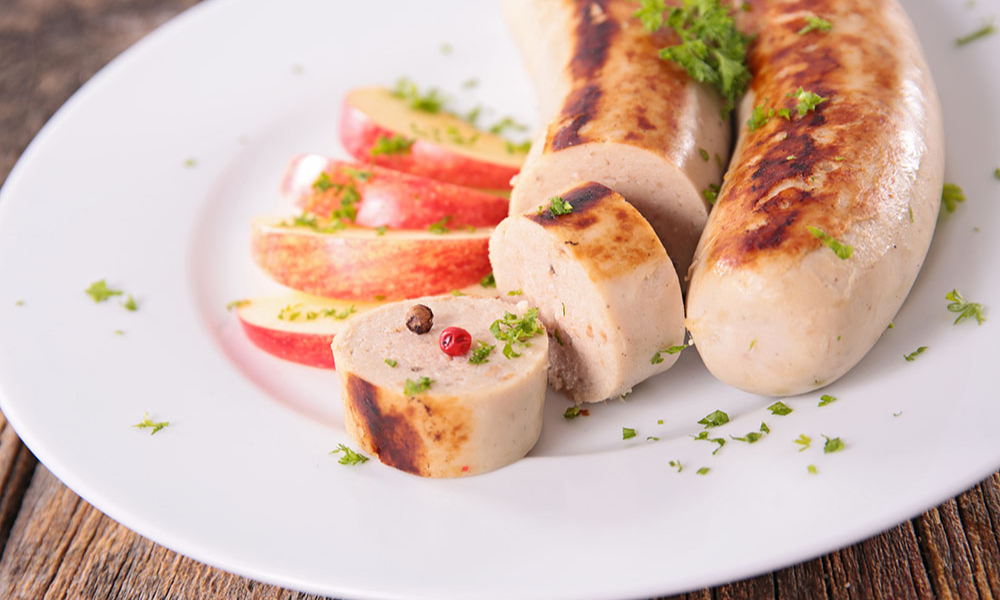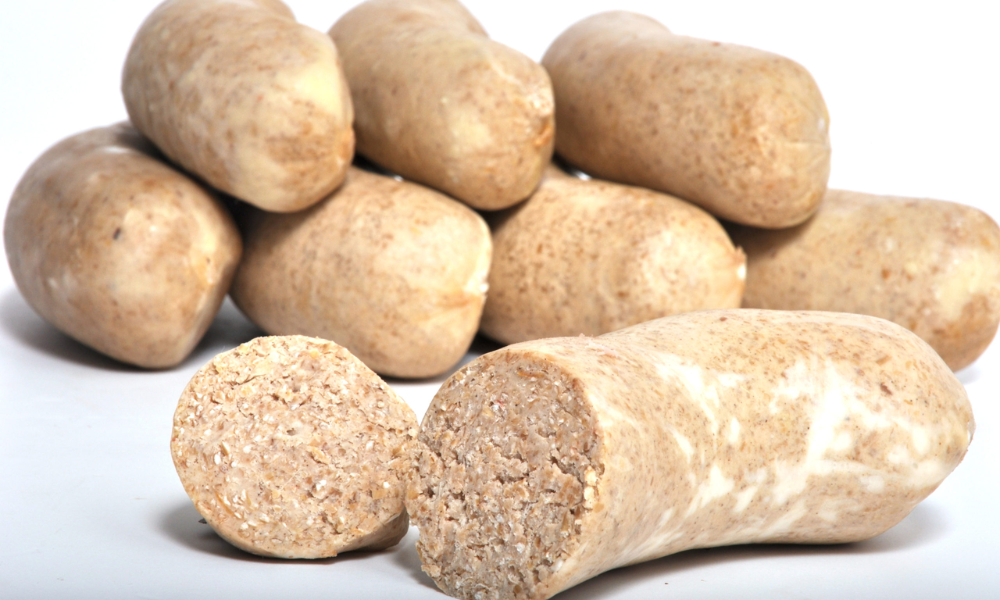White Pudding prepared in Ireland, is a typical Scottish oatmeal dish. It is frequently served with mince and potatoes, battered and deep-fried at a chip shop, and served with chips as a white pudding dinner, and occasionally used as stuffing for chicken, but typically a different white pudding recipe known as skirlie is used. Although the Irish practice this more frequently than the Scots, some Scots enjoy eating fried pieces of bread with their cooked breakfast.
Really tasty is the finest response to the inquiry, “What is a white pudding?” White pudding often contains toasted oatmeal, onions, beef suet, spices, and seasoning. It is fashioned into tripe skins. Additionally, some butchers utilize pork. The typical shape is that of a sausage, while larger haggis-shaped versions are also popular in Scotland and are typically referred to as mealie pudding. Sheep brain matter was a component of very old, traditional Scottish recipes for white pudding; it was added as a binding agent rather than for flavor. Some Scottish butchers and retailers also sell vegetarian white pudding.
What is the White Pudding?
In Scotland, Ireland, Canada, and even some areas of England, people often eat white pudding, which is similar to an oats sausage. Despite the fact that recipes come from all over the world, the majority of them ask for breadcrumbs, cereal grain (such as oatmeal or barley), animal fat (such as pork or beef suet), spices (such as white pepper or coriander), and sometimes even a protein (either pork meat or pork liver).
Before cooking the pudding and letting it cool in cold water, chefs mix all of these ingredients together inside a sausage casing. Cooking the sausage may involve frying, grilling, or deep-frying it in full links or coins, depending on the chef’s preference.
Recipes for white pudding were originally developed by butchers as a means to utilize offal (or animal organs). Other types of offal foods include haggis, which is a savory Scottish pudding, and black pudding, which is made with pork or cattle blood to give it a darker color and bolder flavor. Both of these recipes come from Scotland.
How to Make White Pudding?
Ingredients:
- 225 g Cooked pearl barley
- 90 g of finely sliced leeks
- 120 g all-purpose flour
- 250 g full milk
- 90 g Corn starch
- kosher salt, 15 g
- white pepper, grams
- Celery seed, 5 g
- Coriander powder, 2.5 grams.
- 5 g of clove powder
- the middle of beef or hog casings
Instructions:
- Back fat should be diced up and partially frozen.
- Cook the pearl barley per the directions on the box in some chicken stock while the fat is freezing. Once completed, weigh out the proper quantity and set it aside to cool.
- Leeks should be finely chopped and sautéed in a little olive oil until they start to soften. When finished, allow them to cool and set them aside.
- Grind your fat into a 6mm plate when it has been refrigerated.
- Add the cooked leeks, weighed-out cooked barley, seasonings, flour, cornstarch, and milk to the ground fat. Stir gently to blend.
- Place this mixture inside beef middles or natural hog casings.
- Cook for 35–40 minutes at 176°F.
- Slice the sausage, then pan-fried it until the outside is crispy.
- Enjoy after serving.
Four Different Types of White Pudding
Different regions of the world create white pudding slightly differently:
1. Scottish:
Scottish white pudding, also known as mealy pudding, is made using oats and lard as its foundation ingredients, along with spices and onions or leeks. It typically does not contain hog flesh. Scottish white pudding is typically served with “mince and tatties” (minced beef and potatoes) or deep-fried in a chippy. Another roughly related Scottish dish, fruit pudding, mixes raisins or other dried fruits with sausage.
2. Irish:
To enhance flavor and texture, Irish white pudding may contain a variety of additional ingredients, such as potato flour, pork, and spices. It is a crucial component of a typical full Irish breakfast.
3. Canadian:
Oatmeal serves as the major ingredient of Canadian white pudding, which is popular in Nova Scotia and Newfoundland and is less fatty or meaty than other white puddings.
4. English:
In some parts of England, such as Northumberland in the north and Somerset, Cornwall, and Devon in the south, white pudding is prepared in a variety known as hog’s pudding which is highly spiced.
Differences Between Black and White Pudding
The classic oatmeal-based sausages known as white and black pudding were created by butchers to employ offal or animal innards after the animals were killed. They do differ in a few culinary ways, though:
1. Ingredients:
While white pudding and black pudding have the same fundamental ingredients—oatmeal, suet, and spices—the addition of cow’s or pig’s blood to black pudding alters both its flavor and texture. White pudding is simply a standard oatmeal sausage; black pudding is a blood sausage due to the addition of blood.
2. Color:
Traditional white pudding is light brown or beige, resembling oatmeal, while black pudding recipes call for blood, giving the sausage a darker hue like crimson, black, or dark brown.
3. Flavor:
Since oatmeal and pork fat makes up the majority of white pudding’s ingredients, it often has a mild onion and spice flavor. Blood sausage, on the other hand, contains blood and has richer, earthier flavors. It can also taste slightly metallic.
How to Store White Pudding?
There are tight guidelines for distributing and preserving puddings at home because they don’t contain preservatives. For their texture to be suitably thick for consumption, puddings should be kept at a temperature of 2–6 °C. The desserts usually liquefy fast if kept at room temperature.
Pudding is a mixture that has been stabilized in a variety of methods; as a result, it does not readily tolerate freezing and subsequent defrosting, which permanently ruins the texture’s dense and smooth appearance. Puddings are extremely perishable food items, hence the best before dates for these delicacies must be strictly respected. It is not recommended to store pudding in an opened cup for an extended period of time.
It should be consumed right away after opening because it has a tendency to dry up on the surface and could decompose microbiologically under unfavorable storage circumstances. Since the product sizes are so modest (puddings are offered in Estonia in 125-gram and 250-gram cups), anyone who enjoys pudding may do it.
Puddings are admirable goods that can be consumed as a cold, creamy addition to cakes or used to create a variety of desserts when combined with jam, fruits, berries, chocolate chips, and other components.
Is New Orleans Known for its Bread Pudding?
If you’ve ever visited the French Quarter, you’ll notice that this dish is served seemingly everywhere. However, bread pudding is neither a “thing” of New Orleans nor of America. It has English roots, and many other nations have variations that are similar to it. Simply said, it was a tasty and cost-effective method to use up old bread.
Is Bread Pudding the Same as Bread and Butter pudding?
No, they prepare themselves slightly differently. Bread pudding is made with chunks of dense bread (such as French bread, challah, or brioche), milk, eggs, spices, and typically some form of alcoholic beverage. Spreading butter over numerous thin pieces of bread results in bread and butter pudding.
Typically, only plain white bread will do. They are then put into a baking dish, covered with a sauce that resembles custard, and cooked. Different preparations but with similar themes.
Can Bourbon Sauce-Topped Bread Pudding be Frozen?
With some restrictions, yes. According to this recipe, you should coat the bread pudding with the bourbon sauce three times. The first step is to fill the bottom of the baking pan with 1/3 of the sauce, as directed. It then says to pour a third of the sauce over the bread pudding before baking. The cooked bread pudding is next to be served with the leftover sauce, according to the instructions.
Bread pudding should be carefully wrapped in two layers of plastic wrap before freezing. For up to three months, freeze. Thaw in the refrigerator overnight, then at room temperature for one hour to serve and rewarm. For around 20 minutes, reheat the food in a 350°F oven.
When using a glass or ceramic pan, use additional caution because these materials are sensitive to fast temperature changes. Placing a cold pan in a hot oven can cause it to break. Make sure the food is nearly at room temperature before you put it in the oven to reheat it.
How Should Leftovers be Kept?
This keeps for up to 5 days in the refrigerator when stored covered in a dish or in an airtight container. Although it can be frozen, I don’t advise doing so with the glaze. It will last for up to three months if it is wrapped in plastic wrap, followed by a layer of foil. Allow to defrost in the refrigerator, then reheat covered in the oven until well heated. After making the glaze, serve.
Can you Freeze White Pudding?
Oatmeal pudding and white pudding are pretty similar. White pudding is also called mealy pudding. It surprisingly freezes well. Packing the pudding tightly is key to keeping the smooth texture of white pudding after thawing. You can achieve that by using a resealable food bag or an airtight container. To avoid freezer burns, use two food bags if you’re using them.
Let the white pudding cool fully before packaging it for the freezer. If you are using an airtight container, scoop the pudding into it, allowing approximately an inch of room. Cling wrap the container’s top and then secure it with the airtight lid. Place in the freezer after writing the storage date.
Conclusion
Popular meat dishes in Ireland, Scotland, Northumberland, Nova Scotia, and Newfoundland include white pudding, oatmeal pudding, and mealy pudding (in Scotland). Although it doesn’t include blood, white pudding is broadly comparable to black pudding. Modern versions call for suet or fat, oats or barley, breadcrumbs, and occasionally pig and pork liver, all of which are stuffed into cellulose or natural sausage casing.

